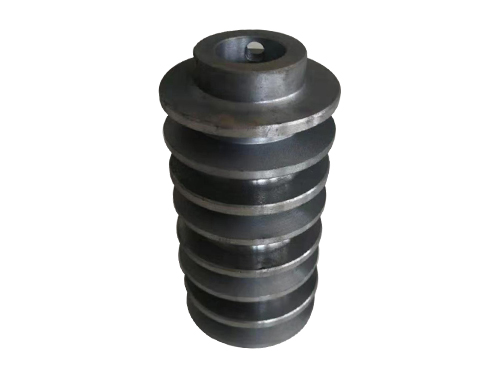Welcome
13503278266
PRODUCT CATEGORY
NEWS
pulley


The belt pulley is a kind of hub parts, generally the relative size
is relatively large, and the manufacturing process is mainly casting and
forging. Generally, the larger size is designed by casting method, the
material is generally cast iron (good casting performance), and cast
steel is rarely used (poor casting performance of steel); Generally, the
smaller size can be designed as forging, and the material is steel.
Pulley is mainly used for long-distance transmission of power, such as
small diesel power output, agricultural vehicles, tractors, automobiles,
mining machinery, mechanical processing equipment, textile machinery,
packaging machinery, lathe, forging machine, some small horsepower
motorcycle power transmission, agricultural machinery power
transmission, air compressor, reducer, reducer, generator, gin and so
on.
The advantages of belt pulley drive are: the belt pulley
transmits kinetic energy to ease the impact of load; The belt pulley
drives smoothly with low noise and vibration; The structure of belt
pulley drive is simple and easy to adjust; The manufacturing and
installation accuracy of pulley drive is not as strict as meshing drive;
The belt pulley drive has the function of overload protection; The
adjustment range of the center distance between the two shafts of the
belt pulley drive is large. The disadvantages of belt drive are: the
belt pulley drive has elastic sliding and slipping, the transmission
efficiency is low and the accurate transmission ratio can not be
maintained; When the belt pulley transmission transmits the same large
circumferential force, the profile size and shaft pressure are larger
than the meshing transmission; The service life of the pulley drive belt
is short. All kinds of mechanical equipment pulley diameter and other
dimensions are matched according to the deceleration ratio, and designed
according to the working speed and motor speed. Working speed / motor
speed = diameter of driving pulley / diameter of driven pulley * 0.98
(sliding coefficient). If steel pulley is used, the linear speed shall
not be higher than 40m / S; if cast iron pulley is used, the linear
speed shall not be higher than 35m / s. conversion ratio between motor
speed and pulley diameter: speed ratio = output speed: input speed =
pitch circle diameter of load pulley: pitch circle diameter of motor
pulley. The diameter of pitch circle is the same as the reference
diameter, the diameter is -2h= the diameter of the pitch circle, h is
the groove depth of the reference line, the V-belt h of different models
is different, Y Z a B C D E, and the groove depth of the reference line
is h = 1.622.753.54.8 8.19.6 respectively. The diameter of the pulley
pitch circle is the theoretical diameter of the pulley joint line
position, which is a bit like the diameter of the gear indexing circle.
PD is generally used for the outer circle, OD is generally used for the
outer circle. The conversion formula of different groove type pitch
circle and outer circle is different. Generally, we can easily measure
the outer circle of the pulley. According to the formula, the pitch
circle is calculated.Spz:od=pd+4; SPA:OD=PD+5.5; SPB:OD=PD+7;
SPC:OD=PD+9.6。 The small outer diameter of pulley a or spa is 80mm, if
it is less than this size, especially in high speed, the belt is prone
to delamination and cracks at the bottom. SPZ belt, small wheel not less
than 63mm can. At the same time, pay attention to the installation
method and tension of belt, too small and easy to slip, too large and
easy to damage the belt and bearing.


